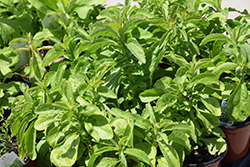Fri & Sat 8am - 8pm
Sun 8am - 7pm
Anytown, USA 12345
fax: 261.787.0463
e-mail: info@successgc.com


Plant Finder

Height: 3 feet
Spread: 3 feet
Sunlight:
![]()
![]()
Hardiness Zone: 8b
Description:
A sub-tropical, spindly, and many branched plant producing small clusters of tubular white flowers nearly year round; the leaves are not aromatic but possess a natural sweetness when tasted; leaves can be used fresh or dried in salads, baking or teas
Edible Qualities
Sugar Love Stevia is a perennial herb that is commonly grown for its edible qualities, although it does have ornamental merits as well. The serrated pointy green leaves can be harvested at any time in the season. The leaves have a sweet taste.
The leaves are most often used in the following ways:
- Fresh Eating
- Eating When Cooked/Prepared
- Baking
- Drying
- Tea
Features & Attributes
Sugar Love Stevia is primarily valued in the garden for its ornamental upright and spreading habit of growth. It features dainty clusters of lightly-scented white flowers at the ends of the stems from early spring to late fall. Its serrated pointy leaves remain green in color throughout the season.
This is an herbaceous perennial herb with an upright spreading habit of growth. Its wonderfully bold, coarse texture can be very effective in a balanced garden composition. This is a relatively low maintenance plant, and is best cleaned up in early spring before it resumes active growth for the season. It is a good choice for attracting butterflies to your yard. It has no significant negative characteristics.
Aside from its primary use as an edible, Sugar Love Stevia is sutiable for the following landscape applications;
- Mass Planting
- General Garden Use
- Container Planting
Planting & Growing
Sugar Love Stevia will grow to be about 3 feet tall at maturity, with a spread of 3 feet. It tends to be leggy, with a typical clearance of 1 foot from the ground, and should be underplanted with lower-growing perennials. It grows at a medium rate, and under ideal conditions can be expected to live for approximately 15 years. As an herbaceous perennial, this plant will usually die back to the crown each winter, and will regrow from the base each spring. Be careful not to disturb the crown in late winter when it may not be readily seen!
This plant can be integrated into a landscape or flower garden by creative gardeners, but is usually grown in a designated herb garden. It does best in full sun to partial shade. It prefers to grow in average to moist conditions, and shouldn't be allowed to dry out. This plant should not require much in the way of fertilizing once established, although it may appreciate a shot of general-purpose fertilizer from time to time early in the growing season. It is particular about its soil conditions, with a strong preference for poor, acidic soils. It is somewhat tolerant of urban pollution. This particular variety is an interspecific hybrid. It can be propagated by division; however, as a cultivated variety, be aware that it may be subject to certain restrictions or prohibitions on propagation.
Sugar Love Stevia is a good choice for the edible garden, but it is also well-suited for use in outdoor pots and containers. With its upright habit of growth, it is best suited for use as a 'thriller' in the 'spiller-thriller-filler' container combination; plant it near the center of the pot, surrounded by smaller plants and those that spill over the edges. It is even sizeable enough that it can be grown alone in a suitable container. Note that when growing plants in outdoor containers and baskets, they may require more frequent waterings than they would in the yard or garden.
